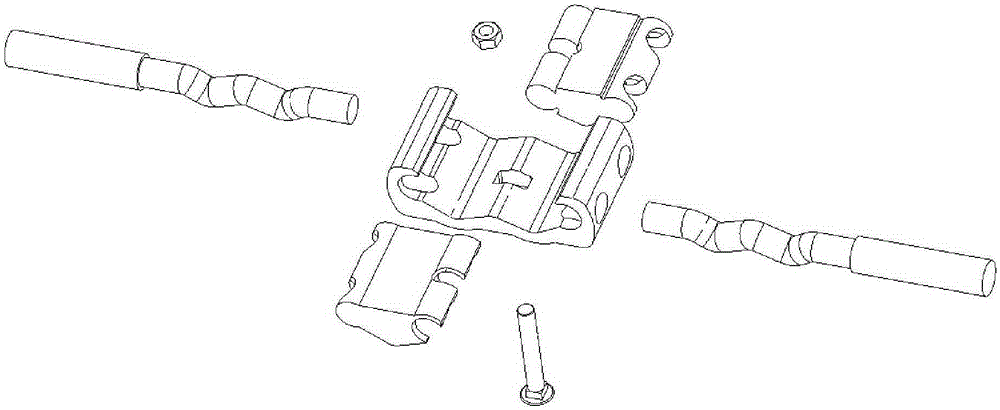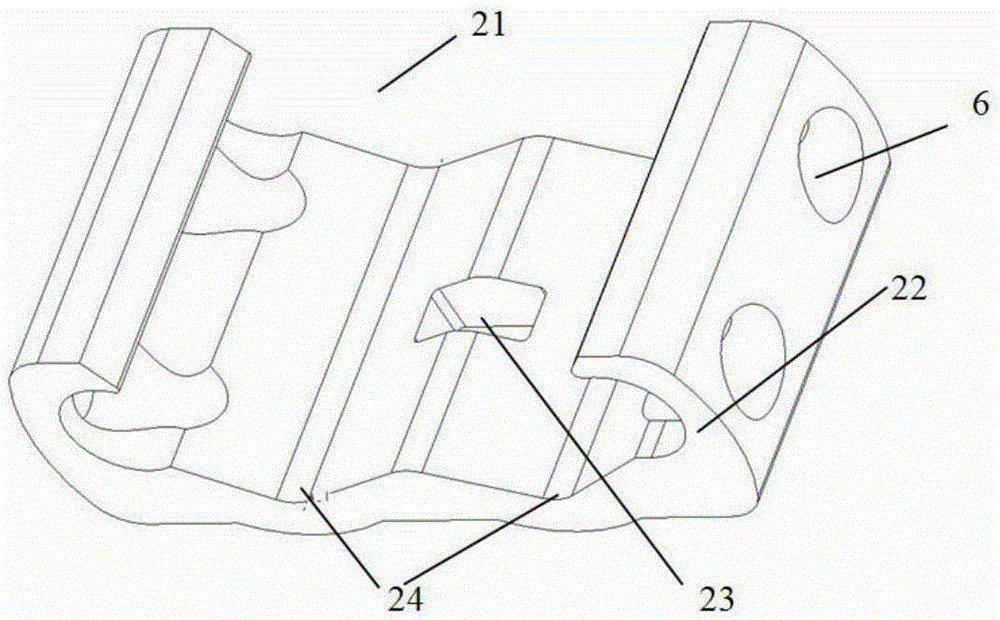Wire connector
A wire splicer and splicer technology, applied in the direction of adjusting/maintaining mechanical tension, cable suspension devices, etc., can solve the problems of poor mechanical bearing capacity, wire falling off, and cumbersome pressing tools, etc. The effect of stable and reliable use and good tension bearing capacity
- Summary
- Abstract
- Description
- Claims
- Application Information
AI Technical Summary
Problems solved by technology
Method used
Image
Examples
Embodiment 1
[0063] A wire connector includes a connector body 2, a locking block 3 on the connector body 2, and a locking device for detachably connecting the connector body 2 and the locking block 3. One surface of the connector body 2 Correspondingly, a concave-convex crimping structure is provided on one surface of the locking block 3, and at least one of the connector body 2 and the locking block 3 is provided to prevent The limiting structure for the wire to slide down laterally. When in use, the wire is set between the concave and convex crimping structure of the connector body 2 and the concave and convex crimping structure of the locking block 3, and is limited by the limiting structure. Under the action of the tightening force, the wire is locked and bent to prevent longitudinal sliding.
[0064] The wire connector is provided with at least two connector bodies 2, and each connector body 2 is provided with a locking block 3 and a locking device for detachably connecting the connecto...
Embodiment 2
[0075] On the basis of the technical solution of the wire terminal clamp described in Embodiment 1, the following improvements are further made:
[0076] Such as image 3 As shown, the main body groove is a "C-shaped" groove, or the main body groove is an "O-shaped" groove. The locking device includes a locking screw 4.
[0077] The body groove is a "C-shaped" groove, and the connector body 2 and the locking block 3 are respectively provided with a first hole and a second through hole, and the second through hole is located in one of the sub-blocks. On or between the two sub-blocks, the first through hole and the second through hole are both light holes, and the locking screw 4 passes through the first through hole and the second through hole to cooperate with a locking nut 5, The connector body 2 and the locking block 3 can be detachably connected and locked, or one of the first through hole and the second through hole is a light hole, and one through hole can be connected to the...
Embodiment 3
[0085] On the basis of the technical solution of the wire terminal clamp described in Embodiment 1 or Embodiment 2, the following improvements are further made:
[0086] The locking screw 4 is arranged at the center of the terminal clamp body 2, and the installation direction of the locking screw 4 is perpendicular to the wire insertion direction.
[0087] Such as Figure 1 to 7 As shown, the locking block 3 is composed of two sub-blocks, a male block 31 and a female block 32, the opposite ends of the male block 31 are convex arc structures, and one end of the female block 32 is a convex arc The opposite end of the convex arc structure and the concave arc structure are both greater than 180°. The convex arc structure at one end of the male block 31 is hinged to the connector body 2, and the other end The convex arc structure of the female block 32 is fitted into the concave arc structure of the female block 32 to form an articulation. The convex arc structure of the female block 3...
PUM
 Login to View More
Login to View More Abstract
Description
Claims
Application Information
 Login to View More
Login to View More - R&D
- Intellectual Property
- Life Sciences
- Materials
- Tech Scout
- Unparalleled Data Quality
- Higher Quality Content
- 60% Fewer Hallucinations
Browse by: Latest US Patents, China's latest patents, Technical Efficacy Thesaurus, Application Domain, Technology Topic, Popular Technical Reports.
© 2025 PatSnap. All rights reserved.Legal|Privacy policy|Modern Slavery Act Transparency Statement|Sitemap|About US| Contact US: help@patsnap.com



